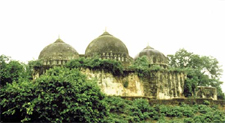| A judgement by the Lucknow bench of the Allahabad High Court on the Ayodhya title suit is expected to address a large number of issues. But, first a brief history of the various suits filed over a large period of time.
As it is not party to the case the Centre cannot challenge any verdict before the Supreme Court. It, however, has powers to enact a law to undo a court order. The litigants: There are five title suits before the court. The Hindu Mahsabha's late Gopal Singh Visharad and Paramhansa Ramchandra Das, who were the first two people to file the title suits in 1950, are now represented in the case by their son Rajenda Singh Visharad and disciple Mahant Ram Das respectively. Other litigants to the dispute are the Nirmohi Akhara, which filed the third suit in December 1959 and wishes to assume control of the property. The Sunni Central Wakf Board filed in 1961 seeking declaration of the structure as a mosque and removal of idols and other articles and also asking for the plot to be handed over to it. All four suits were combined in 1964. In July 1989 retired Allahabad high court judge Deoki Nandan Agrawal filed yet another suit on behalf of the 'Ram Lalla' (young Ram) which has been installed at the site. His representatives are now party to the case. The Babri Masjid Action Committee has become a litigant by proxy. Historically the first suit goes back to 1885 when Mahant Raghubar Das filed a title suit in a Faizabad court to build a 'chabutra' (raised platform) on the outer courtyard of the disputed structure. His suit was dismissed on the ground that the alleged demolition of an original Ram temple in 1528 had occurred over 350 years earlier and it was 'too late now' to remedy the grievance. Friday's judgment will not be a final verdict on the dispute as it can be appealed in the Supreme Court by any one of the contending parties. An initial Supreme Court ruling can also be appealed through a curative petition and the matter referred to a larger bench. The Issues Major issues:
Lets wait and watch ...... what finally happens......... we have take that........ Because we are Indians.......... Regards Santosh Sharma | |
Total Pageviews
Wednesday, September 29, 2010
Issues involved in the Ayodhya title suit
Subscribe to:
Post Comments (Atom)
 Status: Currently, the Centre is the statutory receiver of all the disputed 67.7 acres of land through the Acquisition of Certain Area at Ayodhya Act 1993 pending settlement of the land title dispute. This is the position since 7 January 1993.
Status: Currently, the Centre is the statutory receiver of all the disputed 67.7 acres of land through the Acquisition of Certain Area at Ayodhya Act 1993 pending settlement of the land title dispute. This is the position since 7 January 1993.
No comments:
Post a Comment